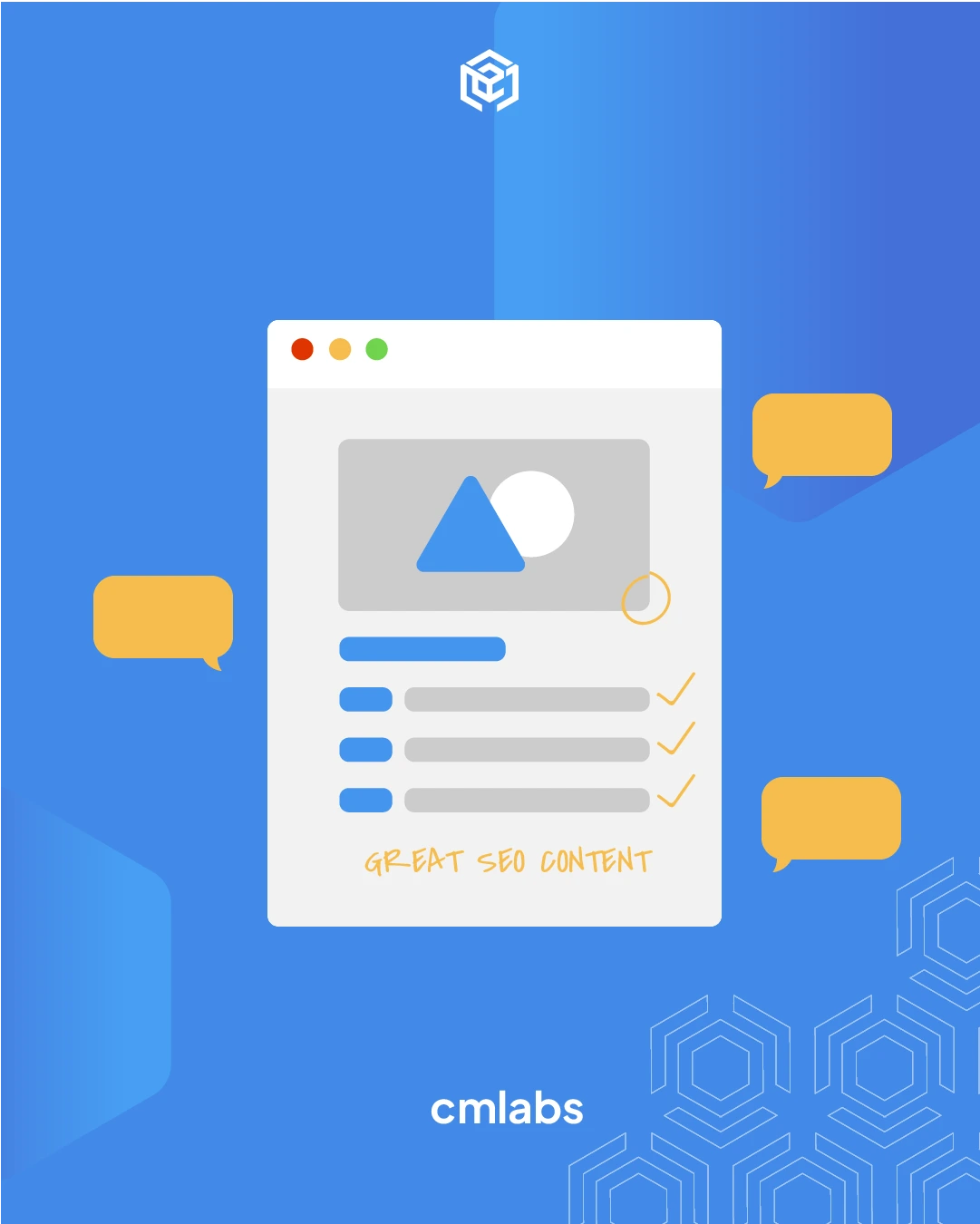We use cookies
This site uses cookies from cmlabs to deliver and enhance the quality of its services and to analyze traffic..
SEO SERVICES
Conduct in-depth technical website audits, strategically develop website projections, and increase your website authority.
ASO SERVICES
Elevate Your App’s Presence with Our Expert ASO Services – Boost Visibility and Drive Downloads!
WRITING SERVICES
We offer a variety of writing services to suit different business necessities. Reach broader audiences or lead specific industries? We've got you covered!
Get relevantly positive media exposure from bloggers and online publishers to increase your brand mentions on search engine results pages.
SEOlutions
A unified source of truth!
SEO & Digital Maternity Solution
SEO & Digital Maternity Solution: Leverage Cross-Platform Insights to Elevate Your Strategy with Expert Consultation
SEO & Digital Maternity Solution
Data Solution options:
Starting from Rp200 mio
Reinventing how a company get creative treatments
A new way to get your creative needs done. Agile team, efficient cost, and expedient way in a flexible yet scalable subscription plan!
Creative-as-a-Services
CaaS package options:
Based on Subscription
Pioneer in digital marketing software powerhouse
We’re excited to unveil our new range of Tech Solutions designed to drive your digital success. Whether you’re looking to enhance your website’s performance, streamline your tech stack, or unlock deeper insights from your data, we’ve got you covered.
Starting from Rp250 mio
Our Clients
Research and innovation center for digital transformation
Digital marketing combines technical skills and business knowledge at every stage. For marketing teams, improving budget management efficiency is crucial, as time is an invaluable resource that should be used wisely. At Sequence, we are dedicated to empowering you to optimize efficiency and strategic planning, ultimately enhancing the impact of your digital marketing efforts.
Subscription-based (IDR1,800/keyword)
Our Clients
BeyondSEO
References
SEO Tools for Webmasters
SEO Tools for Writers
SEO Tools
FIND THE SUITABLE PARTNERSHIP FOR YOUR COMPANY
Check out which cmlabs partnership program suits your company
WHITE LABEL SEO
for CorporateYour company is granted exclusive partnership rights to provide SEO services to our important clients, and we will provide a dedicated backend team to support your efforts.
AFFILIATE PROGRAM
for BizdevA new affiliate program is being introduced for skilled marketers and individuals with strong networks, offering commissions of up to 7% for generating profits independently.
DIGITAL AGENCY
for Marketing Partnerscmlabs is an essential partner for digital agencies, providing a unique selling proposition in Search Engine Optimization (SEO).
BACKLINK PARTNERSHIP
for Media / BloggerWe have a vast database of bloggers and media outlets across Indonesia, categorized by region and media type, giving our clients an edge in managing their media and SEO activities.
OFFICIAL TRAINING
We provide ongoing professional development and support to SEO professionals to ensure they are equipped to meet market demands.
JOIN AS CONTRIBUTOR
for Content WriterGreat opportunity for SEO Writers around the world. T&C applied!
ACADEMIC PARTNERSHIP
Through partnerships with universities in Indonesia, cmlabs has helped align academic curricula with industry demands.
Partnership
Sector & Industries
Tell us your SEO needs, our marketing team will help you find the best solution
As an alternative, you can schedule a conference call with our team
Schedule a Meeting?Contact
Survey
We use cookies
This site uses cookies from cmlabs to deliver and enhance the quality of its services and to analyze traffic..
Last updated: Oct 07, 2022
A user agent is a piece of software that retrieves, renders, and facilitates interaction between end users and website content. Its role is to be the mediator that communicates end-user requests to the server.
An example of a user agent, or UA, is a browser that retrieves website content on a server and displays it to the user. The way it works is to process user instructions, transfer them to the server, and receive the requested data from the server.
When communicating with the server, the UA will provide information regarding its identity or characteristics. The information provided is the software name, software version, operating system, device model, software vendor, software revision, and others. This information is delivered to the server in the form of a string in the HTTP request header.
The string function of the agent is to negotiate content with the server. That is, the server will use the information in the string to assess its capabilities and provide data accordingly.
To easily understand the form of the string in the HTTP request header, you can see the example of the syntax below. You need to remember that each agent has a different string and information content. Check out the example of the string below:
Mozilla/5.0 (Linux; Android 6.0.1; Nexus 5X Build/MMB29P) AppleWebKit/531.21.10 (KHTML, like Gecko) Chrome/79.0.3945.136 Mobile Safari/537.36
The following describes each component in the UA string:
Based on the example above, the agent tells the server that the user's instructions come from the Android device so that the server will send the website display with the mobile version to the user.
The information contained in the string can also be used as user data that is stored on the server and used for audience analysis purposes.
As explained earlier, user agents are browsers used by users, such as Google Chrome, Mozilla Firefox, Safari, Opera, and so on. In addition to the browser, there are several other pieces of software that are considered user agents, which are:
After understanding all there is to know about user agents, you may wonder “what is my user agent?”. The identity is not easy to define because it is given by your browser. Nevertheless, you can also change it.
You can change the string by performing spoofing. This process will cause your UA to send a string with information that does not match the original. This action is harmless and can actually help you as an SEO professional.
The purpose of spoofing is to identify any cloaking problems on the website. Cloaking is the condition when a website displays different content to Googlebot or other users.
This condition is considered by Google as a violation and is included in the black hat SEO category. By doing spoofing, you can identify cloaking on the website.
WDYT, you like my article?
Couldn't find result for "Mulki" try to search with different keyword
Suggestion:
Tell us your SEO needs, our marketing team will help you find the best solution
As an alternative, you can schedule a conference call with our team
Schedule a Meeting?



cmlabs Jakarta Jl. Pluit Kencana Raya No.63, Pluit, Penjaringan, Jakarta Utara, DKI Jakarta, 14450, Indonesia
(+62) 21-666-04470These strategic alliances allow us to offer our clients a wider range of SEO innovative solutions and exceptional service.

Psst! Hey there, SEO Stats and Tools SEO company! If you've ever planned of conquering the Indonesia market, you've come to the right place!